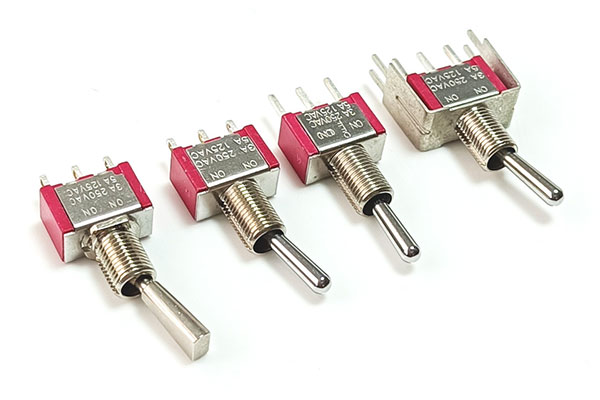Knowledge
How to choose the toggle switch for the modular synthesizer
Choosing the right toggle switch for your modular synthesizer is more than just a matter of aesthetics or convenience—it's an essential decision that can affect the overall performance, reliability, and ease of use of your system. Modular synthesizers are intricate, dynamic instruments that rely on precise control and signal routing, and the toggle switches you incorporate into your build play a pivotal role in how those controls function. Whether you're building a custom synth from scratch, upgrading an existing setup, or replacing worn-out switches, understanding the critical factors involved in selecting the best toggle switch is crucial for achieving the desired results.

The Role of Toggle Switches in Modular Synthesizers
Toggle switches are used in modular synthesizers to control a variety of functions, such as selecting between different signal paths, enabling or disabling certain features, toggling between different modes of operation, or even powering the unit on and off. Depending on the module's function, the switch can either interrupt or connect specific signal paths, send control voltages, or perform other tasks related to modulation or signal routing. A toggle switch can also be used to activate features like resets, switching between presets, or enabling certain oscillators, filters, or effects.
In a modular synthesizer, where flexibility and ease of interaction are paramount, the right toggle switch can make all the difference in ensuring your setup functions smoothly, intuitively, and reliably.
Key Considerations for Choosing the Right Toggle Switch
When selecting a toggle switch for your modular synthesizer, several factors must be considered to ensure it meets both your technical requirements and ergonomic preferences. Here's a breakdown of the key considerations:
1. Switch Type and Functionality
Toggle switches come in various types, and the most common for modular synths are SPST (Single Pole Single Throw) and DPDT (Double Pole Double Throw) switches. The type of switch you choose should be based on how many circuits or signal paths you need to control.
SPST switches are the most basic and control a single circuit, either opening or closing it (on/off).
DPDT switches are more versatile and can control two circuits, often used for switching between multiple signal paths or modes.
Momentary vs. Latching: A momentary toggle switch only stays activated while pressed (usually used for short-term functions like triggering a gate), while a latching switch stays in its last position (on or off), which is typical for toggling between two states in a modular synth.
2. Form Factor and Mounting Type
The form factor of the switch should be compatible with the modular synth panel you’re working with. Common mounting types include PCB-mounted and panel-mounted switches. PCB-mounted switches are easier to install and are ideal for more compact designs where space is a premium. Panel-mounted switches, on the other hand, require drilling into the synth's enclosure but offer a more robust and accessible interface.
Additionally, consider the size and profile of the switch. If you plan to use multiple switches in close proximity, smaller switches or those with a low profile may be necessary to avoid clutter.
3. Electrical Specifications
Understanding the electrical requirements of your system is critical when choosing a toggle switch. The switch needs to handle the current and voltage levels of the signals it's controlling. In a modular synthesizer, most control voltages (CV) and audio signals fall within a certain range, but it's important to verify that the switch you're considering can handle these levels without causing issues like signal degradation or failure.
Current Rating: Ensure the toggle switch can handle the required current for the intended signal path.
Voltage Rating: Verify the voltage rating to ensure compatibility with the power source and other components in the system.
Switching Power: If the switch will control more power-intensive components (e.g., an oscillator or an external device), make sure it is rated for the corresponding load.
4. Durability and Tactility
Durability is crucial, particularly in a modular synthesizer, where frequent interaction and physical manipulation of components are the norm. Look for switches that are built to last, with high-quality materials like metal contacts and durable housings. Consider the actuation force and feel of the switch, as you'll want a switch that’s easy to toggle without too much resistance, but also one that won't accidentally flip when touched lightly.
Many musicians prefer tactile switches that give a noticeable feedback when toggled, ensuring they can feel when a switch has been properly engaged.
5. Aesthetics and User Experience
The tactile and visual aspects of the switch should align with the overall design and usability of your modular synthesizer. Choose switches that complement the look and feel of your other components. For example, toggle switches with colored caps or distinctive toggle levers can help make the switch easier to identify, especially in more complex systems with many controls.
Additionally, the placement of switches should be considered in the context of how you’ll interact with the instrument. Ensure that frequently used switches are easily accessible and positioned ergonomically.
Selecting the right toggle switch for your modular synthesizer is a balance between functionality, technical specifications, and personal preference. By carefully considering the type, size, durability, and electrical requirements of the switches, you can ensure that your modular system operates seamlessly and suits your specific needs. Whether you're controlling a simple on/off function or toggling between complex signal routing paths, the right toggle switch can make a world of difference in your workflow and overall experience with your modular synthesizer.
RELATED NEWS
- Can a metal button switch be integrated with indicator lights 2025-12-08
- The difference between a momentary and a latching metal button switch 2025-12-08
- What size is the broadcasting illuminated push button 2025-12-03
- Video illuminated push button 2025-12-03
- Are DIP switches still widely used nowadays 2025-11-03
CATEGORIES
LATEST NEWS
CONTACT US
Contact: Bella
Phone: 15999819066
E-mail: rucoe@rucoe.com
Whatsapp:+86-15999819066
Add: Taoyuan Street, Nanshan, Shenzhen
